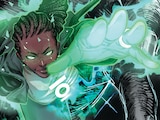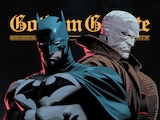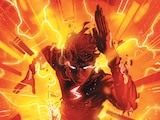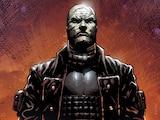As a project developed by Bruce Timm, it’s pretty impossible not to compare the new Batman: Caped Crusader to its spiritual predecessor, Batman: The Animated Series. Both projects draw heavy inspiration from the earliest days of the Dark Knight, as we first knew him under the pen of Bob Kane and Bill Finger. If anything, Caped Crusader draws from that well even deeper. Yet, from the very first episode, there’s an element which sets this new series apart from every attempt we’ve seen so far to channel these initial Batman adventures.
It’s no accident that episode one of Batman: Caped Crusader opens on a reimagined feminine incarnation of the Penguin, boisterous, beloved and big-bodied. Nor that it presents us with a mature, adult Barbara Gordon, ideologically opposed to her father as the city’s fiercest defense attorney, standing tall for the rights of the accused. Caped Crusader makes a statement up top that this project will not be a parade of “Timm’s Women”—the demure gun molls hanging off the arms of colorful villains, or seducing our stoic hero, who could all share the exact same wardrobe. The Gotham City of Caped Crusader is defined not so much by Batman, but by the women who inhabit it.
Barbara Gordon and Detective Renee Montoya are this series’ true stars, in the same way Frank Miller and Dave Mazzuchelli’s Batman: Year One make James Gordon the star of Batman’s story, shrouding its title figure in mystery. Even the women Batman faces on the other side of the law have no masculine arms to drape themselves upon, defining their own stories. This one’s for the girls of Gotham.
BARBARA GORDON

Perhaps even more than it’s a Batman show, Batman: Caped Crusader is a Barbara Gordon show. Throughout the entire first season, Barbara never puts on a costume, but the emotional beats of the series and the strongest sense of character progression always emanate from her. Reimagined as a defense attorney, Barbara is cast as the opposing viewpoint to her father, police Commissioner Jim Gordon, representing two people trying to save a city bedeviled by corruption from different sides: one by standing up for the victims of a broken law enforcement system, and the other attempting to mend the system itself from within.
But Caped Crusader’s Barbara Gordon is never defined by her relationship with her father or, for that matter, by Batman, even as they build a fledgling alliance. This Barbara has her own motivations, her own friends, her own rivals and her own struggles. She’s called “Barbara,” “Ms. Gordon,” “Barb” and “Babs” to different people in her life, each indicative of a different facet of her interpersonal relationships. It’s Barbara who is brought to question her own ideals when she’s made the target of one of her own clients and Barbara who must reckon with the sacrifice made by a rival in the season finale. As seen through the lens of his embattled therapy sessions, the Caped Crusader is a static character. We can’t wait to see how Barbara grows in the season to come.
RENEE MONTOYA

One of the most thrilling aspects of Batman: Caped Crusader is how it reunites the much-loved Gotham Central comics team of Ed Brubaker and Greg Rucka on its writing staff. Over twenty years ago, Gotham Central redefined the way we look at the internal dynamics of the Gotham City Police Department, and the few idealistic officers who stand against an overwhelmingly corrupt system. It’s exactly that GCPD to which Caped Crusader returns. And who better to stand for it than Gotham Central’s protagonist, and original Batman: The Animated Series creation, Renee Montoya?
A decade before Gotham Central, we first got to know Officer Montoya in the early Batman: The Animated Series episode “P.O.V.,” told largely through the detective’s perspective. Rucka and Brubaker would pick Montoya up as their own point of view character through Gotham Central to navigate the system, ultimately arriving at the conclusion that the only ethical action a police officer in Gotham City can make is to quit.
In Caped Crusader, we find Timm’s original vision of the stalwart police officer married to the nuanced protagonist Rucka and Brubaker developed—even injecting her queerness back into the narrative, giving us an unexpected but surprisingly tantalizing relationship between the detective and psychiatrist Harleen Quinzel…who has even more surprises in store herself.
HARLEY QUINN

The first and second episodes of Caped Crusader take the time to introduce us to Gordon and Montoya, our two female leads, and the third follows with the first season’s most compelling villain: an entirely reimagined incarnation of Bruce Timm’s most celebrated co-creation, Harley Quinn. Once the anonymous henchgirl to the Joker, devised by the animators for a punchline, Harley has grown to take on a more vibrant life than nearly any other character in DC history.
Batman: Caped Crusader takes the three decades of evolution we’ve seen the once Joker-lovelorn Harleen go through and morphs it into something entirely new. We meet Dr. Quinzel in “Kiss of the Catwoman,” as Bruce Wayne’s court-mandated therapist after he gets into a brawl at a gala event. Though she doesn’t necessarily uncover his identity, Dr. Quinzel proves to possess a keen insight that exposes Bruce to more of his innermost self than he’s comfortable seeing. But like the other women in Caped Crusader, Dr. Quinzel exists outside of Batman’s gaze. We see her as an accomplished criminal profiler, a close friend of Barbara Gordon, a paramour to Detective Montoya…and the most chilling figure in the series.
Halfway through the season, Dr. Quinzel reveals herself to us as the crusading Harley Quinn—a terrifying masked crusader who makes her wealthiest clients, the billionaire class of Gotham, disappear into her “playroom.” After their “playtime,” the city always comes out better…and the clients come out worse. Perverting her “Mad Love” origins as a well-meaning psychiatrist corrupted by the Joker, Caped Crusader presents its Harley Quinn as a figure with no less lofty intentions, but cruel and corrupt from within. If there’s a connection between her and the Joker, we don’t know it yet. But she doesn’t need it to be just as haunting as the clown himself.
Other women of Gotham, including Selina Kyle, the vampiric Nocturna, The Dark Knight Returns’ Carrie Kelly, and even new original characters like actress Yvonne Frances all get their chance to shine throughout Caped Crusader. If you’re looking for an evolution in the Bruce Timm vision of Gotham City, then this is it. Harley Quinn no longer needs a Joker to carry her story, as Montoya needs no Bullock, and even Barbara Gordon needs no Batman. Don’t let the title fool you—these are the standout characters to watch. Not all crusaders wear capes.
Batman: Caped Crusader is now streaming on Prime Video.
Alex Jaffe is the author of our monthly "Ask the Question" column and writes about TV, movies, comics and superhero history for DC.com. Follow him on Bluesky at @AlexJaffe and find him in the DC Official Discord server as HubCityQuestion.
NOTE: The views and opinions expressed in this feature are solely those of Alex Jaffe and do not necessarily reflect those of DC or Warner Bros. Discovery, nor should they be read as confirmation or denial of future DC plans.




















